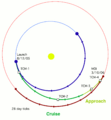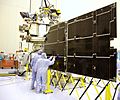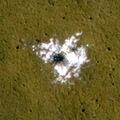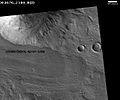Mars Reconnaissance Orbiter facts for kids

Artist's impression of the Mars Reconnaissance Orbiter spacecraft.
|
|
| Mission type | Mars orbiter |
|---|---|
| Operator | NASA / JPL |
| Website | |
| Mission duration | Primary mission: 2 years Elapsed: 20 years, 4 months and 4 days from launch 19 years, 9 months and 6 days (7028 sols) at Mars |
| Spacecraft properties | |
| Manufacturer | Lockheed Martin / University of Arizona / APL / ASI / Malin Space Science Systems |
| Launch mass | 2,180 kg (4,810 lb) |
| Dry mass | 1,031 kg (2,273 lb) |
| Payload mass | 139 kg (306 lb) |
| Power | 2,000.0 watts |
| Start of mission | |
| Launch date | August 12, 2005, 11:43:00 UTC |
| Rocket | Atlas V 401 |
| Launch site | Cape Canaveral SLC-41 |
| Contractor | ILS |
| Orbital parameters | |
| Reference system | Areocentric |
| Regime | Sun-synchronous |
| Inclination | 93 degrees |
| Mars orbiter | |
| Orbital insertion | March 10, 2006, 21:24:00 UTC MSD 46990 12:48 AMT 20 Dhanus 211 Darian |
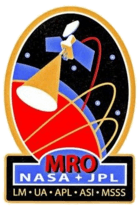 Official insignia of the Mars Reconnaissance Orbiter mission. |
|
The Mars Reconnaissance Orbiter (MRO) is a special NASA spacecraft. It was launched on August 12, 2005, from Cape Canaveral, Florida. The MRO arrived at Mars on March 10, 2006. Since then, it has been orbiting Mars and studying the planet.
The main goal of the MRO is to search for signs of water on Mars. This includes looking for water on the surface, under the surface, and in the atmosphere of Mars. To help with this, the MRO carries the largest telescope ever sent to another planet. The orbiter also acts like a communications satellite. Its powerful antennas help send and receive messages between NASA on Earth and the rovers exploring the surface of Mars.
Contents
Exploring Mars from Orbit
The Mars Reconnaissance Orbiter is packed with amazing tools. These tools help it study Mars in many ways. It looks at the planet's surface, its atmosphere, and even what's hidden underground.
Searching for Water
One of the MRO's most important jobs is to find out more about water on Mars. Scientists believe water is key to understanding if life ever existed there. The MRO uses special cameras and sensors to look for ice and signs of ancient water flow.
It has found evidence of water ice buried just below the surface. It has also spotted places where water might have flowed in the past. This information is very important for future missions to Mars.
Mapping the Martian Surface
The MRO carries a super powerful camera called HiRISE (High Resolution Imaging Science Experiment). This camera can take incredibly detailed pictures of the Martian surface. It can even see objects as small as a kitchen table!
These images help scientists map the planet and study its features. They can see craters, canyons, volcanoes, and even avalanches happening on Mars. HiRISE images also help plan safe landing sites for future rovers and astronauts.
Studying the Atmosphere
The orbiter also keeps an eye on the Martian atmosphere. It studies how the atmosphere changes with the seasons. This includes looking at dust storms and how water vapor moves around the planet. Understanding the atmosphere helps scientists learn about Mars's climate.
MRO as a Communication Hub
The Mars Reconnaissance Orbiter is not just a science lab in space. It also plays a vital role in helping other missions on Mars. It acts as a relay station, sending data back and forth.
Connecting Earth and Mars Rovers
When rovers like Opportunity, Curiosity, and Perseverance are on Mars, they collect a lot of data. Sending this data directly to Earth can be slow. The MRO helps by receiving data from the rovers and then sending it to Earth using its powerful antenna.
This makes communication much faster and more efficient. It's like the MRO is the internet router for Mars! It also helps send commands from Earth down to the rovers.
Observing Landings
The MRO has even captured amazing images of other spacecraft landing on Mars. It took pictures of the Phoenix lander and the Curiosity rover as they descended through the atmosphere. More recently, it photographed the Perseverance rover's parachute during its landing. These images are very helpful for engineers to understand how landings work.
Key Instruments on Board
The MRO carries several important instruments to do its work. Each one has a special job.
- HiRISE (High Resolution Imaging Science Experiment): This is the powerful camera that takes incredibly detailed pictures of the Martian surface. It helps us see small features and changes over time.
- CRISM (Compact Reconnaissance Imaging Spectrometer for Mars): This instrument looks for minerals that form in the presence of water. It helps identify places where water might have been or still is.
- MARCI (Mars Color Imager): This camera takes wide-angle, daily global views of Mars. It helps scientists track weather patterns and dust storms.
- SHARAD (Shallow Radar): This radar instrument can "see" below the surface of Mars. It helps detect layers of ice or rock buried underground.
Images for kids
-
Launch of Atlas V carrying the Mars Reconnaissance Orbiter, 11:43:00 UTC August 12, 2005
-
Image of Phoenix landing on Mars, as seen by HiRISE. Although in the image it appears to be descending into the crater, Phoenix actually landed 20 km (12 mi) away from it.
-
The Phoenix lander and its heatshield as seen by HiRISE
-
Tracks of the rover Opportunity, as seen by HiRISE. The white dots are places where the rover stopped to perform scientific observations or turned.
-
The Curiosity rover during atmospheric entry as seen by HiRISE on August 6, 2012. Supersonic parachute and backshell visible.
-
Perseverance rover parachute descend over the Jezero crater photographed by HiRISE on February 18, 2021.
See also
 In Spanish: Mars Reconnaissance Orbiter para niños
In Spanish: Mars Reconnaissance Orbiter para niños



